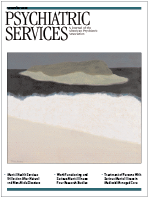Use of Practitioner-Based Alternative Therapies by Psychiatric Outpatients
To the Editor: Persons with affective and anxiety disorders use complementary and alternative therapies at elevated rates to treat psychiatric and physical symptoms (1,2,3,4). Little is known about the use of such therapies among persons with schizophrenia. In our study of health service utilization and comorbid medical illness among outpatients with schizophrenia or affective disorders, patients were asked questions about frequency of visits to alternative care practitioners and the health problems that motivated them to seek this treatment. Items from the Medical Expenditure Panel Survey (MEPS) (4) were used.
Potential participants for the study were patients with schizophrenia and with an affective disorder who were selected randomly from patient rosters of one urban and one suburban psychiatric outpatient center in the Baltimore metropolitan region. Seventy-three percent of those eligible provided informed consent and completed an in-person interview. A total of 100 participants with schizophrenia and 100 participants with an affective disorder were interviewed. Half of each diagnostic group was recruited from each outpatient center.
Participants were asked whether they had visited a provider of any of 12 categories of alternative treatment during the previous 12 months and reasons for this visit. The categories included chiropractic; acupuncture; nutritional advice or lifestyle diets; massage therapy; herbal remedies; biofeedback training; training or practice of meditation, imagery, or relaxation techniques; homeopathic treatment; spiritual healing or prayer; hypnosis; traditional medicine (for example, Chinese medicine); and other treatments.
Thirty-seven percent and 68 percent of patients in the schizophrenia and affective disorder samples, respectively, were women. The proportions of Caucasians were 48 percent and 69 percent, respectively, and of African Americans, 45 percent and 29 percent. Seventy-three percent in the schizophrenia group and 72 percent in the affective disorders group had a high school diploma. The mean±SD ages for the groups were 42.2±9.2 and 45.7±8.3, respectively.
Eleven percent of patients with schizophrenia and 30 percent of patients with an affective disorder had consulted an alternative care practitioner for either physical or psychiatric symptoms. The highest consultation rates among the schizophrenia patients were for spiritual healing or prayer (4 percent), nutritional advice or lifestyle diets (3 percent), and chiropractic (3 percent). The highest consultation rates in the affective disorder group were for herbal remedies (10 percent), spiritual healing or prayer (9 percent), and acupuncture (8 percent). Only 16 percent of patients with affective disorder reported seeking alternative care specifically for mental illness or emotional problems, compared with 36 percent of patients with schizophrenia.
Only previous college attendance was associated with visiting an alternative care practitioner among patients with affective disorder (χ2=4.13, df=1, p=.042). The number of comorbid conditions was the only variable associated with visiting such a practitioner among the patients with schizophrenia. The median number of comorbid conditions was 2.5 for those who reported a visit, compared with 1.0 for those who did not (Wilcoxon p=.001).
An analysis of the 1996 MEPS sample (4) found national rates of use of practitioner-based alternative care by persons in the general population across self-reported mental conditions of between 9 percent and 11 percent, including a rate of 9 percent among 40 participants who reported a psychotic disorder and a rate of 10 percent among 846 participants who reported an affective disorder. These rates are comparable to those in our outpatient schizophrenia sample (11 percent) but not to those in our outpatient affective disorders sample (30 percent).
The results of our analysis underscore the need for providers in mental health and primary care settings, where depression is common, to ask their patients about use of alternative treatments. Such information could indicate the presence of psychiatric or physical symptoms that are not addressed by traditional care (4) or otherwise provide a more complete picture of how patients perceive traditional care, its deficits, and ways in which it could be improved.
The authors are affiliated with the department of psychiatry at the University of Maryland at Baltimore. Dr. Brown is also with the department of epidemiology and preventive medicine at the university.
1. Kessler RC, Soukup J, Davis RB, et al: The use of complementary and alternative therapies to treat anxiety and depression in the United States. American Journal of Psychiatry 158:289–294,2001Link, Google Scholar
2. Unutzer J, Klap R, Sturm R, et al: Mental disorders and the use of alternative medicine: results from a national survey. American Journal of Psychiatry 157:1851–1857,2000Link, Google Scholar
3. Knaudt PR, Connor KM, Weisler RH, et al: Alternative therapy use by psychiatric outpatients. Journal of Nervous and Mental Disease 187:692–695,1999Crossref, Medline, Google Scholar
4. Druss BG, Rosenheck RA: Use of practitioner-based complementary therapies by persons reporting mental conditions in the United States. Archives of General Psychiatry 57:708–714,2000Crossref, Medline, Google Scholar



